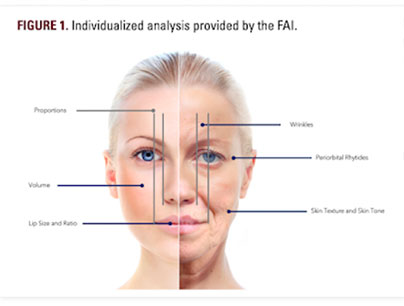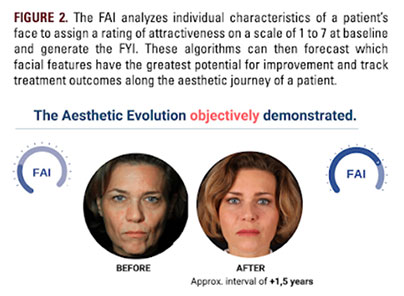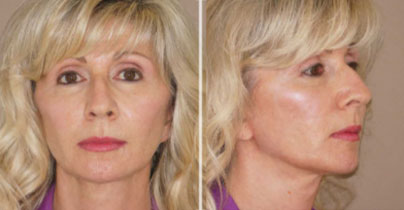Impact of AI on Aesthetic Medicine
Studies show that overall health and wellbeing can be significantly impacted by our facial appearance. Cosmetic rejuvenation is often sought to restore wellness by improving both mental health and self confidence. Whereas most fields of medicine rely heavily on scientific evaluation measurements, with clinicians reaching for a vast range of digital tools with which to achieve accuracy, aesthetic medicine remains largely subjective (and subject to bias) with only a very small number of digital dermatological tools available. Until now.
A new application using artificial intelligence (AI) has been developed to standardize facial landmarks and characteristics for more consistent, unbiased assessment in aesthetic medicine. A detailed analysis of large data sets across gender, age, and ethnicity groups validated by digital images and live assessments contributed to the development of the Facial Aesthetic Index (FAI) and Facial Youthfulness Index (FYI). Using AI-based algorithms these can identify and personalise treatment recommendations whilst providing users with a visible history of treatments and results.
The FAI and FYI aid in diagnosis as well as assisting in consultation by combining a holistic impression of what makes a face attractive alongside mathematical and scientific predictions. This will raise the bar to provide a new standard of care within aesthetic rejuvenation.
The demand for more objective measurements in aesthetic medicine stems from the need to better understand and improve overall health and well-being. As per the World Health Organization, health encompasses physical, mental, and social well-being, and appearance plays a significant role in how we perceive ourselves and are perceived by others.
In today’s society, where social media and video conferencing put a spotlight on facial appearance, there’s a growing desire for both surgical and non-surgical facial procedures. However, the tools to assess dermatological conditions objectively are still lacking. Optimal patient care requires an objective understanding of aesthetics, yet in aesthetic medicine, there’s a challenge: a lack of standardized, impartial evaluation methods.
Unlike many medical fields that rely on clear diagnostic criteria and measurable outcomes, aesthetic medicine struggles with subjective assessment. While some scales exist to evaluate specific facial features, they still depend on subjective grading. Moreover, there’s no universal definition of beauty, making it challenging to set precise treatment goals.
Clinicians’ biases, shaped by culture, environment, and personal experiences, further complicate matters. These biases affect how providers perceive beauty and set treatment priorities, leading to diverse aesthetic ideals and outcomes.
Without objective metrics, facial rejuvenation relies on clinicians’ subjective assessments and anatomical knowledge. This lack of standardized measurements and clear definitions of beauty hinder progress in meeting patients’ expectations and improving satisfaction.
In essence, the need for more objective measurements in aesthetic medicine arises from the desire to enhance overall well-being by better understanding and addressing aesthetic concerns in a standardized and evidence-based manner.
In other areas of medicine, doctors are increasingly using digital tools to help diagnose and manage patients. These tools bring new ways of handling health issues and offer hope for better overall health. The use of health-related mobile apps has become common, with over 350,000 available in 2021. While mental health, diabetes, and heart disease apps are prevalent, there are fewer specific apps for dermatology. However, with the rise of teledermatology, this is likely to change soon, leading to more patient-focused technology and the use of artificial intelligence (AI) to assist in care.
AI is a type of technology that mimics human thinking processes. In healthcare, AI is most commonly used in a field called machine learning. This involves computer algorithms learning from past data to gain knowledge and make sense of new information. Deep learning, a subset of machine learning, is especially useful for analyzing complex data like images. In dermatology and dermatologic surgery, where visual analysis is crucial, AI shows promise in improving patient care. It can help detect skin conditions like melanoma, psoriasis, and acne, and has been successfully used in procedures like biopsies and laser treatments. One interesting use of AI is its ability to accurately estimate a person’s age before and after plastic surgery, which could be valuable in facial rejuvenation procedures.

Digital Health Tool for Objective Facial Analysis
A newly developed digital health tool, the Facial Aesthetic Index (FAI), aims to objectively evaluate facial parameters while minimizing subjective bias in aesthetic assessments. Developed using artificial intelligence, the FAI analyzes over 200 facial variables across 15 facial regions to identify common clinical facial features. By comparing a patient’s unique characteristics with large datasets across gender, age, and ethnicity groups, the FAI generates a 7-point rating score indicating overall attractiveness. Additionally, it produces a Facial Youthfulness Index (FYI), quantifying apparent youthfulness. These algorithms forecast which facial features can be improved and prioritize treatment options for maximum benefit. Visual and mathematical tracking of facial improvements over time encourages patient compliance and provides practitioners with comprehensive documentation for quality assurance. Furthermore, this technology enhances patient-physician trust through education and communication.

FAI’s Assessment Process and Outcome
The FAI assesses individual facial characteristics, assigning an attractiveness rating on a scale of 1 to 7 and generating the FYI. These algorithms forecast potential improvements in facial features and track treatment outcomes throughout the patient’s aesthetic journey. Visual and mathematical tracking provides confirmation of treatment effectiveness, motivating patients to adhere to treatment recommendations. Additionally, it ensures complete documentation for practitioners, improving quality assurance. The FAI also serves as a powerful educational and communication tool, strengthening trust between patients and physicians.
The conclusions from the study on the impact of AI on objectivity in Aesthetic Medicine are as follows:
- The integration of AI-based tools, such as the Facial Aesthetic Index (FAI), presents a promising avenue for achieving more objective evaluations in aesthetic medicine.
- These digital health tools enable a comprehensive analysis of facial parameters, reducing the risk of subjective bias in assessments.
- By leveraging AI algorithms to analyze facial characteristics, such as skin texture, symmetry, and volume, the FAI provides standardized assessments across diverse patient demographics.
- The FAI not only offers a 7-point rating score for overall attractiveness but also generates a Facial Youthfulness Index (FYI), enhancing the assessment of apparent youthfulness.
- Moreover, these algorithms can forecast potential improvements in facial features and track treatment outcomes over time, thereby facilitating better-informed treatment decisions and enhancing patient satisfaction.
- Visual and mathematical tracking of facial improvements serve as a valuable tool for both patients and practitioners, promoting compliance with treatment recommendations and ensuring comprehensive documentation for quality assurance.
- Ultimately, the integration of AI in aesthetic medicine not only enhances objectivity but also strengthens patient-physician communication and trust, contributing to improved patient outcomes and satisfaction.
